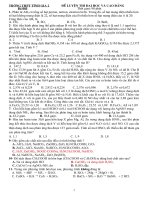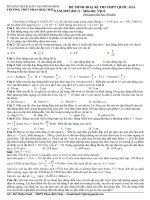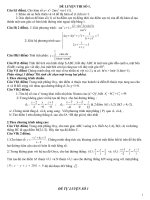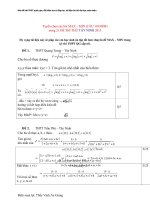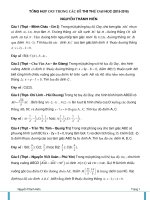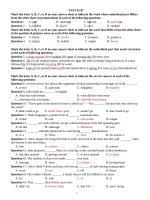- Trang chủ >>
- THPT Quốc Gia >>
- Ngoại Ngữ
Đề thi thử tiếng anh 2020 (có lời giải)
Bạn đang xem bản rút gọn của tài liệu. Xem và tải ngay bản đầy đủ của tài liệu tại đây (5.35 MB, 1,300 trang )
1
20 ĐỀ THI THỬ TIẾNG ANH 2019-2020
CÔ TRANG ANH
ĐỂ SỐ 1
Mark the letter A, B, C, or D on your answer sheet to indicate the word
whose underlined part differs from the other three in pronunciation in each
of the following questions.
Question 1: A. determined B. excited
C. judged
D. seemed
Question 2:
A. nuclear
B. disappear C. pear
D. clear
Mark the letter A, B, C, or D on your answer sheet to indicate the word
that differs from the other three in the position of primary stress in each
of the following questions.
Question 3:
A. presentation B. acquaintance
C. enthusiasm
D.
suspicious
Question 4:
A. district
B. harrow
C. tobacco
D. peasant
Mark the letter A, B, C, or D on your answer sheet to indicate the correct
answer to each of the following questions.
Question 5: If we really to succeed, we must have to work hard.
A. want
B. wants
C. wanted
D. had wanted
Question 6: My responsibility is to wash the dishes and take ______ the garbage
every day.
A. up
B. in
C.on
D. out
Question 7: The problems of the past few months have _______ their toll on her
health and there are shadows under her eyes.
A. taken
B. effected
C. had
D. changed
Question 8: There is no truth in the _______ that Margaret has lost her job.
A. rumor
B. news
C. coverage
D. gossip
Question 9: I've got lots of , but only a few are really good friends.
A. acquainted
B. acquaint
C. acquaintance
D. acquaintances
Question 10: Most children enjoy with their parents and s iblirigs.
A. play
B. to play
C. playing
D. played
Question 11: At this time last night She ________and he _______ the newspaper.
A. is cooking / is reading
B. was cooking / was reading
C. has cooked / is reading
D. was cooking /read
Question 12: The party, _ I was the guest of honor, was extremely enjoyable.
A. at that
B. at which
C. to that
D. to which
Question 13: You always share everything with Lan, so she _ your best friend.
A. must be
B. must have been
C. may be
D. might have
been
2
Question 14: People believe that men make build the house and women make it
home, ______ ?
A. do they
B. don't they
C. will they
D. will you
Question 15: The President expressed his deep ______ over the bombing deaths.
A. grief
B. sorrow
C. sadness
D. all are correct
Question 16: It is parents' duty and responsibility to ______ hands to take care of
their children and give them a happy home.
A. give
B. hold
C. join
D. shake
Mark the letter A, B, C, or Don your answer sheet to indicate the word(s)
CLOSEST in meaning to the underlined word (s) in each of the following
questions.
Question 17: Whenever problems come up, we discuss them frankly and find
solutions quickly.
A. honestly
B. constantly
C. loyally
D. unselfishly
1
3
Question 18: Unselfishness is the very essence of friendship.
A. necessary part B. important part
C. difficult part
D. interesting
part Mark the letter A, B, C, or D on your answer sheet to indicate the
word(s) OPPOSITE in meaning to the underlined word(s) in each of the
following questions.
Question 19: John is the black sleep of the family. He is currently serving 5
years in jail for stealing a car.
A. a member of a family who is regarded as a disgrace and an embarrassment.
B. a member of a family who supports family by raising sheep.
C. a member of a family who confers prestige on his family.
D. a breadwinne r.
Question 20: There must be a mutual trust between friends.
A. reliance
B. belief
C. defendant
D. suspicion
Mark the letter A, B, C, or D on your answer sheet to indicate the
sentence that best completes each of the following exchanges.
Question 21: Ann and Mary are studying in their
classroom. Ann: "Can I borrow you dictionary?"
Mary: "______"
A. I'm afraid I can't.
B. Here you are! C.I think so,
D.
It doesn't matter.
Question 22: Lan and Ba are discussing a question of their teacher.
Lan: I think it is a good idea to have three or four generations living under one roof
Ba:____________________________________.
A. I can't agree with you any more. There will be lots of understanding.
B. No, I don't think so. They can help each other a lot.
C. That's a good idea. Many old-aged parents like to live in a nursing home.
D. You can say that again.
Read the following passage and mark the letter A, B, C, or D on your
answer sheet to indicate the correct word or phrase that best fits each
of the numbered blanks from 23 to 27.
Years ago, in their private family role, women quite often dominate the male
members of the household. Women were quite (23)____ to their families. However,
the public role of women has changed (24)______since the beginning of World
War II. During the war, men were away from home to the battle. As a
(25)_____women were in complete control of the home. They found themselves
doing double and sometimes triple duty. They began to take over the work of
their absent husbands and to work outside. They accounted for 73% of the
industrial labor force. Women were forced by economic realities to work in the
factories. The women (26)______ worked there were paid low wages, lived in
crowded and small dormitories. (27)______they found
themselves a place as active members of
society.
(Source:
haps://goo.91/aeawF4)
Question 23: A. fascinated
B.
C.
D. interested
worried
dedicated
4
Question 24: A. unfortunately B.
approximately
Question 25: A. change B. result
Question 26: A. who
B. whom
Question 27: A. Because B. Therefore
C. nearly
C. success
C. whose
C.
D.
D.
D.
D.
dramatically
opportunity
that
So
5
Read the following passage and mark the letter A, B, C, or D on your
answer sheet to indicate the correct answer to each of the questions
from 28 to 35.
Do you feel like your teenager is spending most of the day glued to a
phone screen? You're not too far off. A new survey from the Pew Research
Center reveals the surprising ways that technology intersects with teen
friendships — and the results show that 57 percent of teens have made at
least one new friend online. Even more surprisingly, only 20 percent of those
digital friends ever meet in person.
While teens do connect with their friends face-to-face outside of school, they
spend 55 percent of their day texting with friends, and only 25 percent of teens are
spending actual time with their friends on a daily basis (outside of school hallways).
These new forms of communication are key in maintaining friendships day-to-day —
27 percent of teens instant message their friends every day, 23 percent connect
through social media every day, and 7 percent even video chat daily. Text
messaging remains the main form of communication — almost half of survey
respondents say it's their chosen method of communication with their closest friend.
While girls are more likely to text with their close friends, boys are meeting
new friends (and maintaining friendships) in the gaming world-89 percent play with
friends they know, and 54 percent play with online-only friends. Whether they're
close with their teammates or not, online garners say that playing makes them feel
"more connected" to friends they know, or garners they've never met.
When making new friends, social media has also become a major part of the
teenage identity-62 percent of teens are quick to share their social media
usernames when connecting with a new friend (although 80 percent still consider
their phone number the best method of contact). Despite the negative
consequences-21 percent of teenage users feel worse about their
lives
because of posts they see on social media — teens also have found support
and connection through various platforms. In fact, 68 percent of teens received
support during a challenging time
in their lives via social media platforms.
Just as technology has become a gateway for new friendships, or a channel
to stay connected with current friends, it can also make a friendship breakup
more public. The study reveals that girls are more likely to block or unfriend
former allies, and 68 percent of all teenage users report experiencing "drama
among their friends on social media."
(Source:
l)
Question 28: What is the main idea of the passage?
A. Social media affects friendship too much.
B. Teenagers are making and keeping friends in a surprising way.
C. The difference of making new friends between girls and boys.
D. Social media connects friendship.
Question 29: The word "digital" in the first paragraph is closest in meaning to .
A. analogue
B. numeracy
C. numerous
D. online
Question 30: According to the passage, what percentage of teens spend actual
time with their friends?
A. 25%
B. 55%
C. 27%
D. 23%
Question 31: The following sentences are true, EXCEPT .
A. According to the survey, more than half of teens have ever made new friends
online.
B. Teens only meet face-to-face one fifth of online friends they have made.
C. Most teenagers use video chat to maintain relationship with friends.
D. New forms of communication play an important role in keeping friendships.
Question 32: The word "they" in paragraph 3 refers to .
A. friends
B. online garners
C. their teammates D. online-only
friends
Question 33: What can be inferred from the passage?
A.
Boys are more likely to meet new friends than girls.
B. Most teens are not easy to give others their usernames when making new
friends.
C. The majority of teenage users agree that social media has negative
consequences in their lives.
D. Thanks to social media, more than two thirds of teens are supported when
they face with challenges in their lives.
Question 34: What is the synonym of the word "breakup" in the last paragraph?
A. termination
B. divorce
C. commencing
D. popularity
Question 35: What does the writer mean when saying "68 percent of all teenage
users report experiencing "drama among their friends on social media""?
A. Most teenagers take part in drama on social media.
B. Most friends on social media of teens are reported in drama.
C. Most teenagers use their experience in drama with their friends on social
media.
D. Most teenagers have ever had conflicts with friends on social media.
Read the following passage and mark the letter A, B, C, or D on your
answer sheet to indicate the correct answer to each of the questions
from 36 to 43.
The difference between the nuclear family and the extended family is that a
nuclear family refers to a single basic family unit of parents and their children,
whereas the extended family refers to their relatives such as grandparents, in-laws,
aunts and uncles, etc. In many cultures, and particularly indigenous societies, the
latter is the most common basic form of social organization.
A nuclear family is limited, according to Kristy Jackson of Colorado State
University, to one or two parents (e.g. a father and mother) and their own child, or
children, living together in a single house or other dwellings. In anthropology, they
only must be related in this fashion; there is no upper or lower limit on the number
of children in a nuclear family.
The extended family is a much more nebulous term, but in essence refers to
kin or relations not covered by the above definition. In historical Europe and Asia as
well as in Middle Eastern, African, and South American Aboriginal cultures, extended
family groups were typically the most basic unit of social organization, The term can
differ in specific cultural settings, but generally includes people related in age or by
lineage.
Anthropologically, the term "extended family" refers to such a group living
together in a household, often with three generations living together (grandparents,
parents, and children) and headed in patriarchal societies by the eldest man or by
some other chosen leadership figure. However, in common parlance, the term
"extended family" is often used by people simply to refer to their cousins, aunts,
uncles, and so on, even though they are not living together in a single group.
(Source: https://goaglissuPq9)
Question 36: What is the passage mainly about?
A. The dominance of nuclear families over extended ones
B. The dominance of extended families over nuclear ones
C. A distinction between nuclear families and extended ones
D. The changes of family types over times
Question 37: The word "the latter" in paragraph 1 refers to
.
A. family unit
B. relatives
C. the nuclear family D. the
extended family
Question 38: The word "nebulous" in passage 3 is closest in meaning to .
A. ambiguous
B. featured
C. difficult
D.incomprehensive Question 39: Historically, extended
families were the most basic unit of social organization in all of the following places
EXCEPT
.
A. The Middle East
B. Asia
C. North America D.
Europe
Question 40: The word "patriarchal" in paragraph 4 is closest in meaning to
.
A. ruled or controlled by men
B. equal for both men and women
C. simple with no rules and laws
D. modern with advanced facilities
Question 41: Which of the following is TRUE according to the passage?
A. Since the 20th century, more and more American couples have lived in
extended families because of the financial burdens.
B. Nuclear families are the most basic form of social organization all over the
world.
C. The popularity of nuclear families in western countries helps to stabilize
family arrangement
D. Traditional nuclear families have changed a lot over times.
Question 42: What can be inferred from the reading passage?
A. Indigenous communities have been completely eradicated all over the world.
B. In the future, all extended families will be replaced by nuclear ones.
C. Anthropology is a science concerning human race and its development.
D. Couples with no children can't be defined as families.
Mark the letter A, B, C, or D on your answer sheet to indicate the
underlined part that needs correction in each of the following
questions.
Question. 43: Meal time is a great time for family members to talk about that is
going on in their lives.
A. is
B. talk about
C. that
D. on in
Question 44: Playing games together is teachable moments to share lessons about
sportsmanship, teamwork, perseverance, and to be tolerant of others.
A. is
B. about
C. to be
D. others
Question 45: The school officials are considering a comprehensive planning to
alleviate the problem of overcrowding in the dormitories.
A. are
B. planning
C. alleviate
D. overcrowding
Mark the letter A, B, C, or D on your answer sheet to indicate the
sentence that is closest in meaning to each of the following questions.
Question 46: There won't be peace in the conflict if both sides do not really desire
it
A. It is only if both sides actually want the conflict to end peacefully that it will
happen.
B. As both sides in the conflict apparently desire peace, it is likely that there
will be peace soon.
C. The main problem in the conflict seems to be that neither side really
desires peace.
D. There has been a lot of fighting in the conflict because both sides seem to
want it that way.
Question 47: The accident happened as a result of the driver's not paying attention
to the road.
A. If the driver would have paid attention to the road, the accident hadn't
happened.
B. Had the driver been paid attention to the road, the accident wouldn't
have happened.
C. If the driver had been paying attention to the road, the accident wouldn't
have happened.
D. Had the accident not happened, the driver would not have had to pay
attention to the road.
Question 48: "Shall I help you do the dishes, Carlo?" said Robert.
A. Robert suggested helping Carlo with the dishes.
B. Robert suggested to help Carlo do the dishes.
C. Robert offered Carlo to help do the dishes.
D. Robert offered to help Carlo do the dishes.
Mark the letter A, B, C, or D on your answer sheet to indicate the
sentence that best combines each
of sentences in the following
questions.
Question 49: I started training to be an accountant one year ago. I had more
months to go and then I had to take exams.
A. By the time I've taken my exam, I will have started training to be an accountant
for a year
B. By the time I take my exam, I will have been in training to be an
accountant for a year.
C. By the time I took my exam, I had been trained to be an accountant for a
year.
D. By the time I've taken my exam, I will be training for a year.
Question 50: I didn't know that you were at home. I didn't drop in.
A. Not knowing that you were at home, but I still dropped in,
B. I didn't know you were at home although I didn't drop in.
C. Not knowing that you were at home, I didn't drop in.
D. If I knew that you were at home, I would drop in.
GIẢI THÍCH CHI TIẾT ĐÁP ÁN
Câu 1: Đáp án B
Kiến thức về
phát âm
“-ed” được phát âm là:
+ /t/: khi âm tận cùng trước nó là /s/, /tʃ/, /ʃ/, /k/, /p/, /f/
+ /id/: khi trước –ed là /t/ và /d/
+ /d/: khi âm tận cùng trước –ed là nguyên âm và các phụ âm còn lại
Đáp án B
Câu 2: Đáp án C
Kiến thức về phát âm
A. nuclear / 'nju:kliə/
B. disappear /disə 'piə/
C. pear /peə/
D. clear /kliər/
Đáp án C (phần gạch chân được phát âm là /eə/, các phương án còn lại được phát
âm là / iə/)
Câu 3: Đáp án A
Kiến thức về trọng âm
A. presentation /,prezen 'teiʃn/: từ này có trọng âm rơi vào âm tiết thứ ba. Vì theo
quy tắc đuôi –tion làm
trọng âm rơi vào trước âm đó.
B. acquaintance /ə 'kweintəns/: từ này có trọng âm rơi vào âm tiết thứ hai. Vì theo
quy tắc đuôi –ance không ảnh hưởng đến trọng âm của từ và trọng âm không rơi
vào âm /ə/.
C. enthusiasm /en 'ɵuzi,æzəm/: từ này có trọng âm rơi vào âm tiết thứ hai. Vì theo
quy tắc trọng âm rơi
vào nguyên âm dài /u:/.
D. suspicious /sə’spiʃəs/: từ này có trọng âm rơi vào âm tiết thứ hai. Vì theo quy tắc
đuôi –ious làm trọng
âm rơi vào trước âm đó.
Đáp án A trọng âm rơi vào âm tiết thứ ba, các phương án còn lại trọng âm rơi vào
âm tiết thứ hai.
Câu 4: Đáp án C
Kiến thức trọng âm
A. district /’distrikt/: từ này có trọng âm rơi vào âm tiết thứ nhất. Vì theo quy tắc
nếu tất cả các âm mà
ngắn hết thì trọng âm rơi vào âm tiết đầu.
B. harrow /’hærəʊ/: từ này có trọng âm rơi vào âm tiết thứ nhất. Vì theo quy tắc trọng
âm không rơi vào âm /əʊ/.
C. tobacco /tə’bækəʊ/: từ này có trọng âm rơi vào âm tiết thứ hai. Vì theo quy tắc
trọng âm không rơi vào âm /ə/ hoặc âm /əʊ/.
D. peasant /’pez ənt/: từ này có trọng âm rơi vào âm tiết thứ nhất. Vì theo quy tắc
trọng âm không rơi vào âm /ə/.
Phương án C trọng âm rơi vào âm tiết thứ ba, các phương án còn lại trọng âm rơi
vào âm tiết thứ nhất.
Câu 5: Đáp án A
Kiến thức về câu điều kiện
Căn cứ vào “if” mà “must have” thì câu này là câu
điều kiện loại 1. Câu điều kiện loại 1 có công thức
như sau:
If + S +V (hiện tại đơn), S + will/can/must… + V
Chủ ngữ của mệnh đề điều kiện là “we” nên động từ phải chia ở dạng số nhiều.
Đáp án A
Tạm dịch: Nếu chúng ta thực sự muốn thành công, chúng ta phải làm việc chăm chỉ.
Câu 6: Đáp án D
Kiến thức về cụm động từ
A. take up: tiếp tục (một công việc bỏ dở…); chọn (một nghề, sở thích ); đảm
nhiệm , gánh vác (một
công việc)
B. take in: hiểu/ lừa gạt
C. take on: đảm nhiệm, thuê mướn
D. take out: nhổ (răng, cây), đổ (rác)
Đáp án D
Tạm dịch: Nhiệm vụ của tôi là rửa bát và đổ rác hàng ngày.
Câu 7: Đáp án A
Kiến thức về cụm từ cố định
To take one’s toll on sb/st = to have a bad effect on someone or something,
especially over a long period of time: gây ảnh hưởng nghiệm trọng/ lâu dài cho ai/
cái gì
Đáp án A
Tạm dịch: Những vấn đề của vài tháng trước đã có ảnh hưởng nghiêm trọng tới sức
khỏe của cô ấy và để lại những quầng mắt.
Câu 8: Đáp án A
Kiến thức về từ vựng
A. rumor /’ru:mə/ (n): đồn đại
B. news /nju:z/ (n): tin tức
C. coverage /’kʌv(ə)ridʒ/ (n): việc đưa tin về những sự kiện
D. gossip /’ gɒsip/ (n): chuyện ngồi lê đôi mách, chuyện tầm phào,
tin đồn nhảm Tạm dịch: Không có tí sự thật nào trong lời đồn
đại rằng Margaret đã mất việc. Câu 9. Đáp án D
Kiến thức về từ vựng
A. acquainted /ə’kweitid/ (a) + with: quen biết, quen thuộc
B. acquaint /ə’kweint/ (v): làm quen
C. acquaintance / ə’kweintəns/ (n): sự quen, người quen
D. acquaintances là danh từ số nhiều
Sau a lot of/ lots of +N (không đếm được)/ N (đếm được ở dạng số nhiều)
Đáp án D
Tạm dịch: Tôi có rất nhiều người quen nhưng thực sự chỉ có một vài người bạn tốt.
Câu 10: Đáp án C
Kiến thức về cấu trúc
Enjoy + Ving: thích làm gì
Tạm dịch: Hầu hết trẻ con thích chơi với bố mẹ và anh em trong nhà.
Câu 11. Đáp án B
Kiến thức về thì động từ
Dấu hiệu nhận biết “at this time last night”. Ta có quy tắc:
+ at this time + trạng từ của quá khứ quá khứ tiếp diễn
Quá khứ tiếp diễn: S + was/were + Ving
Đáp án B
Tạm dịch: Vào thời điểm này tối qua cô ấy đang nấu ăn còn anh ấy thì đang đọc
báo.
Câu 12: Đáp án B
Kiến thức về đại từ quan hệ
Ta có quy tắc: không dùng đại từ quan hệ “that” sau giới từ nên ta loại đáp án A/C
Căn cứ vào mệnh đề quan hệ dạng đầy đủ: “I was the guest of honor at the party”
Đáp án B (at which = at the party)
Tạm dịch: Bữa tiệc mà tôi là khách mời danh dự vô cùng thú vị.
Câu 13: Đáp án A
Kiến thức về động từ khuyết thiếu
A. must be (chắc là, có lẽ là): dùng để diễn tả những suy luận ở hiện tại.
B. must have been (chắc là đã, có lẽ đã): dùng để diễn tả những suy luận ở quá khứ.
C. may be (có thể): dùng để diễn tả những khả năng có thể xảy ra ở hiện tại nhưng
không chắc chắn.
D. might have been (có thể đã): dùng để diễn tả những khả năng có thể xảy ra ở
quá khứ nhưng không
chắc chắn.
Căn cứ vào động từ “share” đang ở thì hiện tại đơn nên ta loại đáp án B/D
Tạm dịch: Cậu luôn chia sẻ mọi thứ với Lan, vì vậy chắc hẳn cô ấy là bạn thân nhất
của cậu.
Đáp án A
Câu 14: Đáp án B
Kiến thức về câu hỏi đuôi
Câu có các động từ sau: think, belive, suppose, figure, assume, fancy, imgine,
reckon, expect, seem, feel
that + mệnh đề phụ:
- Lấy mệnh đề phụ làm câu hỏi đuôi nếu chủ ngữ của mệnh
đề đầu là “I”. Ví dụ:
I think he will come here, won’t he? (Tôi nghĩ là anh ấy sẽ đến phải vậy không?)
Lưu ý: mệnh đề chính có “not” thì vẫn tính như ở mệnh đề phụ
Ví dụ: I don’t believe Mary can do it, can she?
- Cùng mẫu này nhưng nếu chủ từ không phải là “I” thì lại dùng mệnh đề đầu làm câu
hỏi đuôi.
Ví dụ: She thinks he will come,
doesn’t
People
she?believe
Do đó:
that men make build the house and women make it home,
?
Chủ ngữ của mệnh đề đầu là “people” nên ta hỏi đuôi theo mệnh đề đầu.
Đáp án B
Tạm dịch: Nhiều người tin rằng đàn ông xây nhà, đàn bà xây tổ ấm phải không?
Câu 15: Đáp án B
Kiến thức về từ vựng
A. grief /gri:f/ = B. sorrow /’sɒroʊ/ = C. sadness /’sædnis/: nỗi buồn
Sorrow + at/for/over: sự đau khổ, sự buồn phiền; nỗi đau buồn (do mất mát…)
17
Đáp án B
Tạm dịch: Ngài tổng thống bày tỏ nỗi buồn sâu sắc về những người chết trong vụ
ném bom.
Câu 16: Đáp án C
Kiến thức về cụm từ cố định
A. give/ lend sb a hand = do sb a favor = help sb: giúp ai
18
B. hold hands: nắm tay
C. join hands = work together: chung tay, cùng nhau
D. shake hands: bắt tay
Tạm dịch: Bổn phận và trách nhiệm của cha mẹ là cùng nhau chăm sóc con cái và
cho chúng một gia
đình hạnh phúc.
Đáp án C
Câu 17: Đáp án A
Từ đồng nghĩa
A. honestly /’ɔnistli/ (adv): chân thật, thẳng thắn
B. constantly /’kɔnstəntli/ (adv): liên miên, kiên định
C. loyally /’lɔiəli/ (adv): trung thành
D. unselfishly /ʌn’selfi∫(ə)li/ (adv): không ích kỉ, không màng đến lợi ích cá nhân
Tạm dịch: Bất cứ khi nào có vấn đề gì xảy ra chúng tôi đều trao đổi thẳng thắn và
nhanh chóng tìm ra
hướng giải quyết.
Đáp án A (frankly = honestly)
Câu 18: Đáp án B
Từ đồng nghĩa
A. necessary part: phần cần thiết
B. important part: phần quan trọng
C. difficult part: phần khó khăn
D. interesting part: phần thú vị
Tạm dịch: Tính không ích kỉ là phần hết sức quan trọng của tình bạn.
Đáp án B (essence = important part)
Câu 19: Đáp án C
Từ trái nghĩa
A. a member of a family who is regarded as a disgrace and an
embarrassment (một thành viên trong
một gia đình, người mà được coi như một điều ô nhục và đáng hổ thẹn)
B. a member a family who supports family by raising sheep (một thành viên
trong một gia đình, người
mà nuôi sống gia đình bằng việc nuôi cừu)
C. a member of a family who confers prestige on his family (một thành viên
trong một gia đình người
mà mang lại thanh thế cho gia đình mình)
D. a breadwinner (một trụ cột gia đình)
Tạm dịch: John là một đứa con phá gia chi tử trong gia đình. Nó hiện tại đang thụ án
5 năm tù vì tội ăn trộm xe hơi.
Đáp án C (the black sheep of the family >< a member of a family who confers
prestige on his family)
Câu 20: Đáp án D
Từ trái nghĩa
A. reliance /ri’laiəns/ (n): sự tin cậy, sự tín nhiệm
B. belief /bi’li:f/ (n): lòng tin, sự tin tưởng
C. defendant /di’fendənt/ (n): bị cáo
D. suspicion /səs’pi∫n/ (n): sự nghi ngờ
Tạm dịch: Cần phải có sự tin tưởng lẫn nhau giữa những người bạn.
Đáp án D (trust >< suspicion)
Câu 21: Đáp án
B Tình huống
giao tiếp
Ann và Mary đang học trong lớp.
Ann: Tớ có thể mượn từ điển của bạn được không?
Mary:
.
A. I’m afraid I can’t: tôi e rằng tôi không thể B. Here you are!: đây này bạn!
C. I think so: tôi nghĩ vậy
D. It doesn’t matter: không sao
Đáp án B
Câu 22: Đáp án
D Tình huống
giao tiếp
Lan và Ba đang thảo luận một câu hỏi của giáo viên.
Lan: Tớ nghĩ việc ba hay bốn thế hệ sống chung dưới một mái nhà là một ý kiến hay.
Ba:
.
A. I can’t agree with you any more. There will be lost of understanding. (Tớ hoàn toàn
đồng ý. Sẽ có rất nhiều hiểu nhầm)
B. No, I don’t think so. They can help each other a lot. (Không. Tớ không nghĩ vậy.
Họ có thể giúp đỡ
nhau nhiều)
C. That’s a good idea. Many old-aged parents like to live in a nursing home. (Đó là
một ý kiến hay. Nhiều
cha mẹ già thích sống trong viện dưỡng lão)
D. You can say that again. (Tớ đồng ý với cậu)
Câu 23: Đáp án C
ĐỌC ĐIỀN – Chủ đề: Home life
Kiến thức về từ vựng
A. fascinated /fæsi,neitid/ (a): bị mê hoặc, quyến rũ
B. worried /’wʌrid/ (a): lo lắng
C. dedicated /’dedikeitid/ (a): tận tụy, tận tâm
D. interested /’intristid/ (a): thích thú,
quan tâm Ta có cấu trúc:
- To be fascinated by st: bị mê hoặc, lôi cuốn bởi cái gì
- To be worried about st: lo lắng về cái gì
- To be dedicated to st: tận tụy/ hi sinh cho cái gì
- To be interested in st: quan tâm tới cái gì
Căn cứ vào “to their families”
Đáp án C
Câu 24: Đáp án D
Kiến thức về từ vựng
A. unfortunately /ʌn’fɔ:t∫ənətli/ (adv): một cách đáng tiếc, không may
B. approximately /ə’prɒksimətli/ (adv): khoảng chừng, xấp xỉ
C. nearly /’niəli/ (adv): gần, suýt
D. dramatically /drə’mætikəli/ (adv):
đột ngột Căn cứ vào nghĩa của câu:
21
“However, the public role of women has changed (24)
since the beginning of
World War II.” (Tuy nhiên, vai trò của người phụ nữ đã đột ngột thay đổi từ khi bắt
đầu Chiến tranh Thế giới thứ 2.)
Đáp án D
Câu 25: Đáp án B
22
Kiến thức về cụm từ cố định
A. change /t∫ein(d)ʒ/ (n): sự thay đổi
B. result /ri’zʌlt/ (n): kết quả
C. success /sək’ses/ (n): thành công
D. opportunity /ɑpə’tju:niti/
(n): cơ hội Cụm từ cố định:
As a result = therefore = hence = consequently: do đó, do vậy, kết quả là
Đáp án B
Câu 26; Đáp án A
Kiến thức về đại từ quan hệ
Căn cứ vào “the women” là danh từ chỉ người và động từ “work” nên vị trí trống
cần một đại từ quan hệ chỉ người, đóng vai trò làm chủ ngữ của mệnh đề nên đáp
án là A.
Câu 27: Đáp án C
Kiến thức về liên từ
A. because: bởi vì
B. Therefore: do đó, do vậy
C. However: tuy nhiên
D. So: vì vậy
Ta có, “so” không dùng đứng sau dấu chấm (.), không đứng đầu mệnh đề nên ta loại
D.
Căn cứ vào nghĩa của câu ta chọn C.
“The women who worked there were paid low wages, lived in crowded and small
dormitories. (27)
, they found themselves a place as active members of society.”
(Người phụ nữ người mà được trả lương thấp phải sống trong những khu nhà chật
hẹp. Tuy nhiên, họ thấy mình có vai trò tích cực với tư cách là thành viên của xã
hội)
Dịch bài
Cách đây nhiều năm, trong gia đình riêng của mình, vai trò chính của
phụ nữ là phụ trách các công việc nhà. Phụ nữ rất tận tụy cho gia đình
mình. Tuy nhiên vai trò chung của người phụ nữ đã thay đổi từ khi bắt đầu
Thế chiến thứ 2. Trong thời chiến, đàn ông phải ra mặt trận. Vì vậy, người
phụ nữ phải quán xuyến gia đình. Họ thấy mình phải làm gấp đôi thậm chí
gấp ba phần trách nhiệm. Họ bắt đầu đảm nhiệm công việc của người
chồng đi vắng và phải ra ngoài làm việc. Họ chiếm tới 73% lực lượng lao
động công nghiệp. Phụ nữ bị bắt buộc phải làm việc trong các nhà máy bởi
áp lực kinh tế. Người phụ nữ được trả lương thấp và sống trong những khu
nhà chật hẹp. Tuy nhiên, họ thấy mình có vai trò tích cực với tư cách thành
viên của xã hội.
Câu 28: Đáp án B
CHỦ ĐỀ FRIENDSHIP
Ý chính của đoạn văn này là gì?
A. Phương tiện truyền thông mạng xã hội ảnh hưởng quá nhiều đến tình bạn.
B. Giới trẻ đang kết bạn và giữ tình bạn theo một cách rất đáng ngạc nhiên.
C. Sự khác nhau về cách kết bạn giữa nam và nữ.
D. Phương tiện truyền thông mạng xã hội kết nối tình bạn.
Căn cứ vào thông tin đoạn đầu tiên:
A new survey from the Pew Research Center reveals the surprising ways that
technology intersects with teen friendships – and the results show that 57 percent
of teens have made at least one new friend online. Even more surprisingly, only 20
percent of those digital friends ever meet in person.
(Một cuộc khảo sát mới do trung tâm nghiên cứu Pew thực hiện cho thấy những
cách đáng ngạc nhiên mà công nghệ can thiệp vào tình bạn và kết quả chỉ ra rằng
57% thanh thiếu niên đã kết bạn với ít nhất một người bạn trực tuyến. Thậm chí
đáng ngạc nhiên hơn, chỉ có 20% số người bạn trực tuyến đó đã từng gặp mặt ngoài
đời)
Câu 29: Đáp án D
Từ “digital” trong đoạn 1 gần nhất với từ
.
A. vật tương tự
B. sự giỏi toán
C. nhiều
D. trực tuyến
Xét nghĩa trong bài: digital friends (những người bạn kĩ thuật số) = online friends
(những người bạn trực tuyến)
Câu 30: Đáp án A
Theo bài đọc, tỉ lệ thanh thiếu niên thực sự dành thời gian cho bạn
bè mình là bao nhiêu? A. 25%
B. 55%
C. 27% D.
23%
Căn cứ thông tin đoạn 2:
While teens do connet with their friends face-to-face outside of school, they
spend 55 percent of their day texting with friends, and only 25 percent of teens are
spending actual time with their friends on a daily basis (outside of school hallways).
(Mặc dù giới trẻ thực sự có kết nối trực tuyến với bạn bè của họ bên ngoài trường
học, nhưng họ dành 55% thời gian trong ngày để nhắn tin với bạn bè và chỉ có 25%
thanh thiếu niên thực sự dành thời gian cho bạn bè mình hàng ngày (ngoài hành
lang trường học)).
Câu 31: Đáp án C
Những câu sau đây là đúng, ngoại trừ
.
A. Theo khảo sát, hơn một nửa thanh thiếu niên đã từng kết bạn trực tuyến.
B. Giới trẻ chỉ gặp mặt 1/5 người bạn trực tuyến mà họ đã làm quen.
C. Hầu hết thanh thiếu niên sử dụng video chat để duy trì tình bạn.
D. Những loại hình giao tiếp mới đóng một vai trò quan trọng trong việc giữ gìn tình
bạn.
Căn cứ thông tin đoạn 2:
(…) and 7 percent even video chat daily. (và 7% giới trẻ sử dụng video chat hằng
ngày)
- Câu A đúng vì căn cứ thông tin: the results show that 57 percent of teens have
made at least one new friend online. (kết quả chỉ ra rằng 57% thanh thiếu niên đã
kết bạn với ít nhất một người bạn trực tuyến)
- Câu B đúng vì căn cứ thông tin: only 20 percent of those digital friends ever meet in
person. (chỉ có 20% số người bạn trực tuyến đó đã từng gặp mặt ngoài đời)
- Câu D đúng vì căn cứ thông tin: These new forms of communication are key in
maintaining friendships day-to-day (những loại hình giao tiếp mới này là chìa khóa
để duy trì tình bạn hằng ngày)
Câu 32: Đáp án B
Từ “they” trong đoạn 3 đề cập đến
.
A. những người bạn
B. những game thủ trực tuyến
C. thành viên cùng đội của họ
D. chỉ những người bạn
trực tuyến Từ “they” thay thế cho cụm từ “những game thủ trực
tuyến” trong câu phía trước.
Whether they’re close with their teammates or not, online gamers say that
playing makes them feel “more connected” to friends they know, or gamers they’ve
